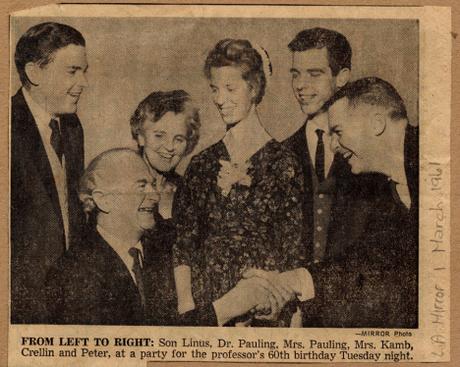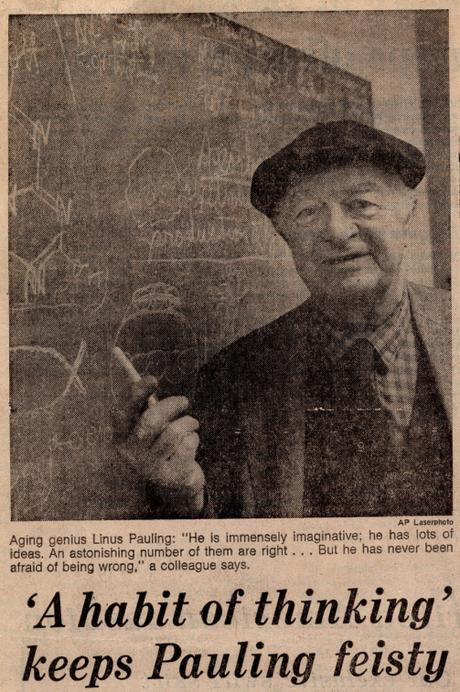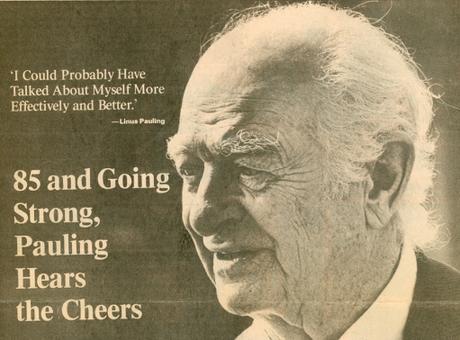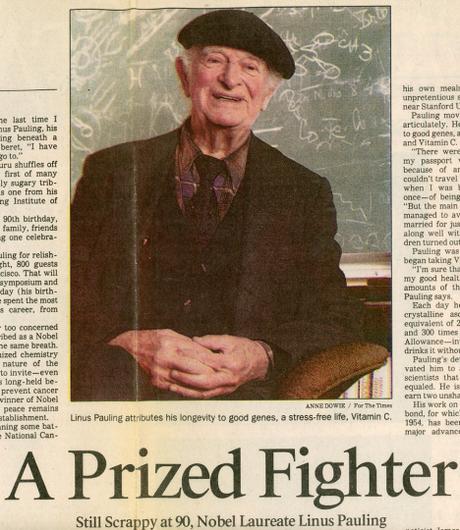
Los Angeles Mirror, March 1, 1961.
In addition to Albert Einstein and perhaps a small handful of others, Linus Pauling stands today as among the most famous of twentieth century scientists. Strong evidence in favor of this claim resides in the more than 3,000 newspaper clippings related to Pauling that are held in the Ava Helen and Linus Pauling Papers, a corpus of material that is bolstered by an additional 2,700 scrapbook leaves, themselves mostly comprised of newspaper clippings as well.
Today, as we celebrate the 116th anniversary of Linus Pauling’s birth on February 28, 1901, we thought it might be interesting to spend some time with all of those newspaper clippings and trace the evolution of Pauling’s birthday as an item of note to the world’s journalists. In so doing, one is also able to delineate differences in the ways that Pauling, as a public figure, was perceived by the media and its readership over time.
Pauling received national media attention for the first time in 1931, when he won the Langmuir Prize from the American Chemical Society at the age of thirty. Newspaper accounts of that award referred to him as a “Prodigy of American Science,” a headline that was used repeatedly in 1946 following Pauling’s receipt of another ACS award, the J. Willard Gibbs Medal.
As Pauling grew older and far more famous, newspapers across the country became increasingly interested in him as a person. When he turned sixty years old on February 28, 1961, the Los Angeles Mirror published the first birthday article that we’ve been able to find in our collection. The write-up, which describes Pauling as “Caltech’s famous Nobel Prize winner in chemistry” focused mostly on his peace work, with which he was heavily involved at the time.
In 1976, on the occasion of Pauling’s 75th birthday, the San Francisco Examiner produced an article commemorating the day. Thus began what would become an almost twenty-year trend: birthday articles on the popular scientist. The 1976 article described Pauling as “cordial and charming, never vindictive.” It also commented on Pauling’s work with vitamin C, focusing especially on its potential applications with cancer.

Chicago Tribune, February 22, 1981
When Pauling’s next big birthday, his 80th, rolled around, the newspapers were there once again to celebrate with him. This time, more than eleven different papers from across the country published articles honoring Pauling. His dedication to widely disparate passions earned him the title “scholar-peacemaker.” Writers also described him as “high energy,” despite having eight decades of a busy life in the rear view mirror. His well-known outspokenness was also frequently commented upon as being a fundamental tenet of Pauling’s personality. One paper, The Fremont-Newark Argus, wrote
He’s always been a bit like a feisty puppy: sinking his teeth into an idea, enthusiastically tossing it around and defying anyone to grab it away. That vigorous and stubborn approach to science – and life – has made Linus Pauling a near-legendary figure.
Four years later, the newspapers were publishing articles to mark Pauling’s 84th birthday. Undeterred by his increasing age, they noted, Pauling was staying as busy ever. He continued with his peace work, notably participating in the Peace Ship Assistance mission to Nicaragua the previous August. Journalists, however, seemed mostly interested in Pauling’s work on vitamin C and the controversy that it provoked, labeling him as both a maverick and a pioneering spirit. Thinking along these lines, The Worcester Sunday Telegram postulated
His unrelenting refusal to admit defeat and his persistent crusades have, over the years, stirred up lingering hostilities of passionate proportions in some scientific and political circles – and a kind of folk-hero reverence elsewhere.

Los Angeles Times, March 6, 1986
The following year, when Pauling turned 85, parties and other gatherings filled his calendar for the weeks around his birthday, and newspapers were once again there to document both the proceedings and the popular view of Pauling. More than ten of them published celebratory articles about the “great dean of science” and wrote of Pauling’s enjoyment at being the center of attention. Multiple reporters likewise noted that, although he had gotten older, Pauling’s humor and self-confidence, not to mention his outspoken habits, had not dissipated.
Pauling was also clearly remaining as busy as a man half his age. As an article in Oregon Magazine pointed out,
It’s hard to argue with a man who keeps up active research, runs his own institute, tours the nation giving dozens of major addresses each year, and has just written a new book – and will celebrate his 85th birthday on February 28.
Though Pauling still conducted scientific research mostly in theoretical chemistry, this component of his life was more frequently mentioned as being a part of his past. Quite clearly, vitamin C was keeping him in the news during the 1980s.
It was 1989 and Pauling was celebrating his 88th birthday by the time the media seemed to realize that he was getting older. Heralded by journalists as one of the most important scientists of all time, Pauling’s good humor and outspoken tendencies continued to intrigue, as did his involvement in discussions regarding nuclear issues. He was also continuing his study, and defense, of vitamin C, and the controversy that his opinions had provoked twenty years earlier had not declined.

Los Angeles Times, February 26, 1991
As he turned 90 years old, Pauling was commonly portrayed as being “the everyman’s scientist.” In 1991, at least forty-seven articles were published in commemoration of his birthday. Newspapers referred to him variously as an “aging guru,” “something of an oddball,” and a patriarch of the very scientific establishment that was so vehemently disagreeing with him. The Chicago Tribune, for one, urged one to consider
a tendency to serious messiness, a devotion to hard work, promotion of a couple of theories hardly anybody else subscribes to, a habit of writing directly to the U.S. president when he’s angry, and a happy delight in discovering things that nobody knew before, and you have the full package: the grand old man of science.
Other papers called him a celebrity, a gadfly, a genius. Scientists and medical professionals interviewed for some of these article disagreed, one of them calling the Linus Pauling Institute of Science and Medicine a “den of cracks.” None of this seemed too important to Pauling who was still continuing work on his three passions: chemistry, peace, and vitamin C. The media also seemed inclined to think that, after thirty years of effort, his support of ascorbic acid was paying off – to journalists anyway, the work appeared to finally be gaining some acceptance.
February 28 of the following year, 1992, was Pauling’s 91st birthday, and it did not go unmarked. His maverick tendencies were again noted. Another year older and in the early stages of declining health, Pauling had become more solitary, spending much of his time either at his Big Sur ranch or closer to the Bay Area at the Institute. The newspapers, which had earlier commented on his pleasure at being the center of attention, now described him as being more comfortable when alone. Even still, Pauling remained extremely active. As an article published in the Arizona Daily Star reported, the nonagenarian was “still publishing scientific papers, still working in the laboratory, and still touting the virtues of C.”
Linus Pauling clearly made an impact not only on matters scientific and peace-related, but also on the average American’s view of what a scientist could be. His persona as a celebrity was both reflected and enhanced by the regular media coverage that attended both his professional activities and his personal milestones. Though now gone for more than twenty-two years, his impact is still strongly felt. Likewise, through newspaper articles and more than 4,000 linear feet of additional materials held in his papers, the Pauling legacy will remain carefully preserved for future generations of scholars, admirers and, yes, journalists.
Advertisements